Weining Wang
3SGen: Unified Subject, Style, and Structure-Driven Image Generation with Adaptive Task-specific Memory
Dec 22, 2025Abstract:Recent image generation approaches often address subject, style, and structure-driven conditioning in isolation, leading to feature entanglement and limited task transferability. In this paper, we introduce 3SGen, a task-aware unified framework that performs all three conditioning modes within a single model. 3SGen employs an MLLM equipped with learnable semantic queries to align text-image semantics, complemented by a VAE branch that preserves fine-grained visual details. At its core, an Adaptive Task-specific Memory (ATM) module dynamically disentangles, stores, and retrieves condition-specific priors, such as identity for subjects, textures for styles, and spatial layouts for structures, via a lightweight gating mechanism along with several scalable memory items. This design mitigates inter-task interference and naturally scales to compositional inputs. In addition, we propose 3SGen-Bench, a unified image-driven generation benchmark with standardized metrics for evaluating cross-task fidelity and controllability. Extensive experiments on our proposed 3SGen-Bench and other public benchmarks demonstrate our superior performance across diverse image-driven generation tasks.
TTP: Test-Time Padding for Adversarial Detection and Robust Adaptation on Vision-Language Models
Dec 18, 2025Abstract:Vision-Language Models (VLMs), such as CLIP, have achieved impressive zero-shot recognition performance but remain highly susceptible to adversarial perturbations, posing significant risks in safety-critical scenarios. Previous training-time defenses rely on adversarial fine-tuning, which requires labeled data and costly retraining, while existing test-time strategies fail to reliably distinguish between clean and adversarial inputs, thereby preventing both adversarial robustness and clean accuracy from reaching their optimum. To address these limitations, we propose Test-Time Padding (TTP), a lightweight defense framework that performs adversarial detection followed by targeted adaptation at inference. TTP identifies adversarial inputs via the cosine similarity shift between CLIP feature embeddings computed before and after spatial padding, yielding a universal threshold for reliable detection across architectures and datasets. For detected adversarial cases, TTP employs trainable padding to restore disrupted attention patterns, coupled with a similarity-aware ensemble strategy for a more robust final prediction. For clean inputs, TTP leaves them unchanged by default or optionally integrates existing test-time adaptation techniques for further accuracy gains. Comprehensive experiments on diverse CLIP backbones and fine-grained benchmarks show that TTP consistently surpasses state-of-the-art test-time defenses, delivering substantial improvements in adversarial robustness without compromising clean accuracy. The code for this paper will be released soon.
ProAV-DiT: A Projected Latent Diffusion Transformer for Efficient Synchronized Audio-Video Generation
Nov 15, 2025Abstract:Sounding Video Generation (SVG) remains a challenging task due to the inherent structural misalignment between audio and video, as well as the high computational cost of multimodal data processing. In this paper, we introduce ProAV-DiT, a Projected Latent Diffusion Transformer designed for efficient and synchronized audio-video generation. To address structural inconsistencies, we preprocess raw audio into video-like representations, aligning both the temporal and spatial dimensions between audio and video. At its core, ProAV-DiT adopts a Multi-scale Dual-stream Spatio-Temporal Autoencoder (MDSA), which projects both modalities into a unified latent space using orthogonal decomposition, enabling fine-grained spatiotemporal modeling and semantic alignment. To further enhance temporal coherence and modality-specific fusion, we introduce a multi-scale attention mechanism, which consists of multi-scale temporal self-attention and group cross-modal attention. Furthermore, we stack the 2D latents from MDSA into a unified 3D latent space, which is processed by a spatio-temporal diffusion Transformer. This design efficiently models spatiotemporal dependencies, enabling the generation of high-fidelity synchronized audio-video content while reducing computational overhead. Extensive experiments conducted on standard benchmarks demonstrate that ProAV-DiT outperforms existing methods in both generation quality and computational efficiency.
PhysCorr: Dual-Reward DPO for Physics-Constrained Text-to-Video Generation with Automated Preference Selection
Nov 06, 2025Abstract:Recent advances in text-to-video generation have achieved impressive perceptual quality, yet generated content often violates fundamental principles of physical plausibility - manifesting as implausible object dynamics, incoherent interactions, and unrealistic motion patterns. Such failures hinder the deployment of video generation models in embodied AI, robotics, and simulation-intensive domains. To bridge this gap, we propose PhysCorr, a unified framework for modeling, evaluating, and optimizing physical consistency in video generation. Specifically, we introduce PhysicsRM, the first dual-dimensional reward model that quantifies both intra-object stability and inter-object interactions. On this foundation, we develop PhyDPO, a novel direct preference optimization pipeline that leverages contrastive feedback and physics-aware reweighting to guide generation toward physically coherent outputs. Our approach is model-agnostic and scalable, enabling seamless integration into a wide range of video diffusion and transformer-based backbones. Extensive experiments across multiple benchmarks demonstrate that PhysCorr achieves significant improvements in physical realism while preserving visual fidelity and semantic alignment. This work takes a critical step toward physically grounded and trustworthy video generation.
Learning Knowledge-based Prompts for Robust 3D Mask Presentation Attack Detection
May 06, 2025Abstract:3D mask presentation attack detection is crucial for protecting face recognition systems against the rising threat of 3D mask attacks. While most existing methods utilize multimodal features or remote photoplethysmography (rPPG) signals to distinguish between real faces and 3D masks, they face significant challenges, such as the high costs associated with multimodal sensors and limited generalization ability. Detection-related text descriptions offer concise, universal information and are cost-effective to obtain. However, the potential of vision-language multimodal features for 3D mask presentation attack detection remains unexplored. In this paper, we propose a novel knowledge-based prompt learning framework to explore the strong generalization capability of vision-language models for 3D mask presentation attack detection. Specifically, our approach incorporates entities and triples from knowledge graphs into the prompt learning process, generating fine-grained, task-specific explicit prompts that effectively harness the knowledge embedded in pre-trained vision-language models. Furthermore, considering different input images may emphasize distinct knowledge graph elements, we introduce a visual-specific knowledge filter based on an attention mechanism to refine relevant elements according to the visual context. Additionally, we leverage causal graph theory insights into the prompt learning process to further enhance the generalization ability of our method. During training, a spurious correlation elimination paradigm is employed, which removes category-irrelevant local image patches using guidance from knowledge-based text features, fostering the learning of generalized causal prompts that align with category-relevant local patches. Experimental results demonstrate that the proposed method achieves state-of-the-art intra- and cross-scenario detection performance on benchmark datasets.
Learning Unknown Spoof Prompts for Generalized Face Anti-Spoofing Using Only Real Face Images
May 06, 2025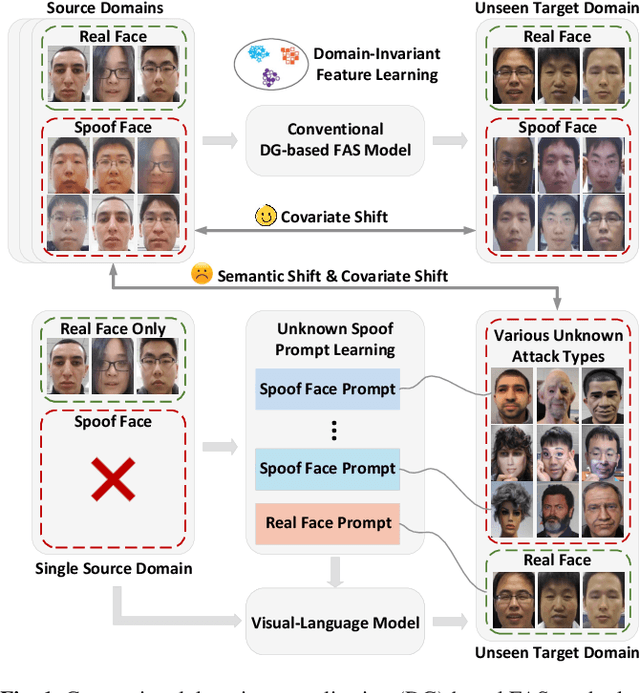
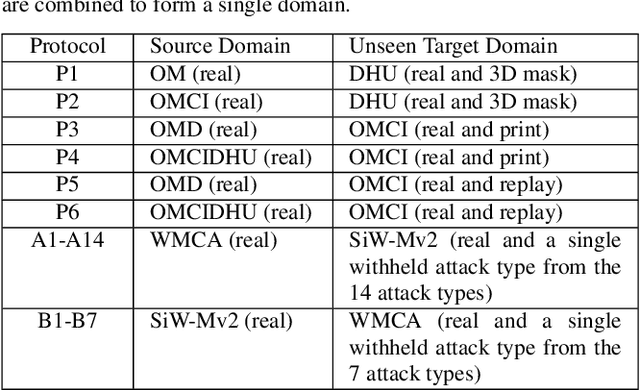
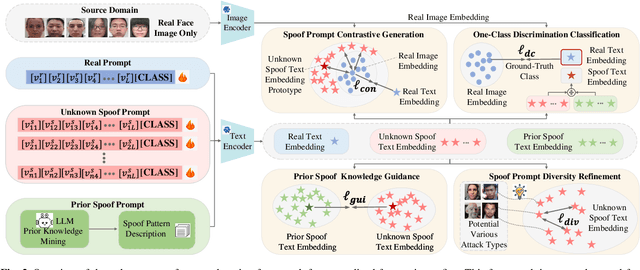
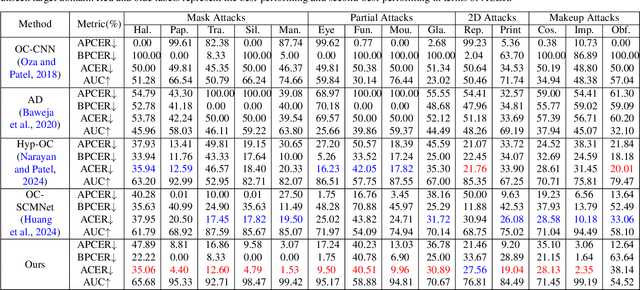
Abstract:Face anti-spoofing is a critical technology for ensuring the security of face recognition systems. However, its ability to generalize across diverse scenarios remains a significant challenge. In this paper, we attribute the limited generalization ability to two key factors: covariate shift, which arises from external data collection variations, and semantic shift, which results from substantial differences in emerging attack types. To address both challenges, we propose a novel approach for learning unknown spoof prompts, relying solely on real face images from a single source domain. Our method generates textual prompts for real faces and potential unknown spoof attacks by leveraging the general knowledge embedded in vision-language models, thereby enhancing the model's ability to generalize to unseen target domains. Specifically, we introduce a diverse spoof prompt optimization framework to learn effective prompts. This framework constrains unknown spoof prompts within a relaxed prior knowledge space while maximizing their distance from real face images. Moreover, it enforces semantic independence among different spoof prompts to capture a broad range of spoof patterns. Experimental results on nine datasets demonstrate that the learned prompts effectively transfer the knowledge of vision-language models, enabling state-of-the-art generalization ability against diverse unknown attack types across unseen target domains without using any spoof face images.
AR-Diffusion: Asynchronous Video Generation with Auto-Regressive Diffusion
Mar 10, 2025Abstract:The task of video generation requires synthesizing visually realistic and temporally coherent video frames. Existing methods primarily use asynchronous auto-regressive models or synchronous diffusion models to address this challenge. However, asynchronous auto-regressive models often suffer from inconsistencies between training and inference, leading to issues such as error accumulation, while synchronous diffusion models are limited by their reliance on rigid sequence length. To address these issues, we introduce Auto-Regressive Diffusion (AR-Diffusion), a novel model that combines the strengths of auto-regressive and diffusion models for flexible, asynchronous video generation. Specifically, our approach leverages diffusion to gradually corrupt video frames in both training and inference, reducing the discrepancy between these phases. Inspired by auto-regressive generation, we incorporate a non-decreasing constraint on the corruption timesteps of individual frames, ensuring that earlier frames remain clearer than subsequent ones. This setup, together with temporal causal attention, enables flexible generation of videos with varying lengths while preserving temporal coherence. In addition, we design two specialized timestep schedulers: the FoPP scheduler for balanced timestep sampling during training, and the AD scheduler for flexible timestep differences during inference, supporting both synchronous and asynchronous generation. Extensive experiments demonstrate the superiority of our proposed method, which achieves competitive and state-of-the-art results across four challenging benchmarks.
MM-LDM: Multi-Modal Latent Diffusion Model for Sounding Video Generation
Oct 02, 2024Abstract:Sounding Video Generation (SVG) is an audio-video joint generation task challenged by high-dimensional signal spaces, distinct data formats, and different patterns of content information. To address these issues, we introduce a novel multi-modal latent diffusion model (MM-LDM) for the SVG task. We first unify the representation of audio and video data by converting them into a single or a couple of images. Then, we introduce a hierarchical multi-modal autoencoder that constructs a low-level perceptual latent space for each modality and a shared high-level semantic feature space. The former space is perceptually equivalent to the raw signal space of each modality but drastically reduces signal dimensions. The latter space serves to bridge the information gap between modalities and provides more insightful cross-modal guidance. Our proposed method achieves new state-of-the-art results with significant quality and efficiency gains. Specifically, our method achieves a comprehensive improvement on all evaluation metrics and a faster training and sampling speed on Landscape and AIST++ datasets. Moreover, we explore its performance on open-domain sounding video generation, long sounding video generation, audio continuation, video continuation, and conditional single-modal generation tasks for a comprehensive evaluation, where our MM-LDM demonstrates exciting adaptability and generalization ability.
COMUNI: Decomposing Common and Unique Video Signals for Diffusion-based Video Generation
Oct 02, 2024

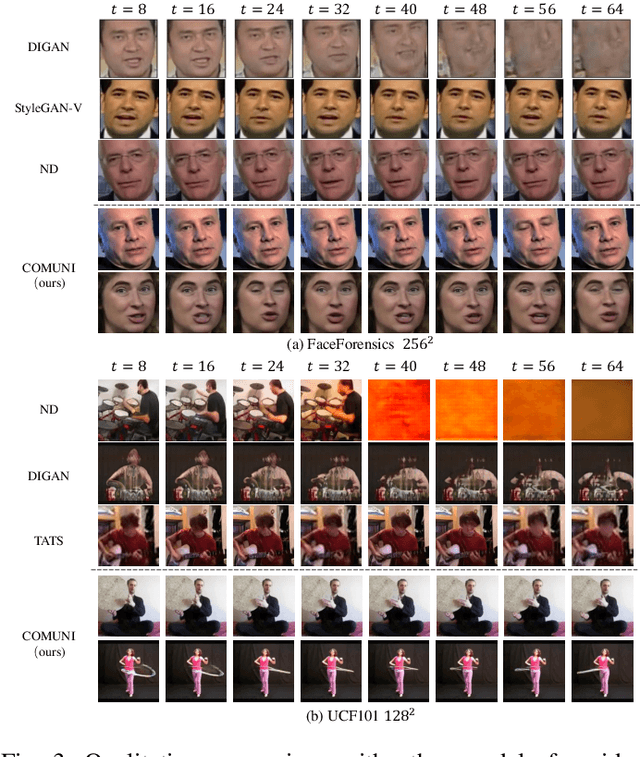

Abstract:Since videos record objects moving coherently, adjacent video frames have commonness (similar object appearances) and uniqueness (slightly changed postures). To prevent redundant modeling of common video signals, we propose a novel diffusion-based framework, named COMUNI, which decomposes the COMmon and UNIque video signals to enable efficient video generation. Our approach separates the decomposition of video signals from the task of video generation, thus reducing the computation complexity of generative models. In particular, we introduce CU-VAE to decompose video signals and encode them into latent features. To train CU-VAE in a self-supervised manner, we employ a cascading merge module to reconstitute video signals and a time-agnostic video decoder to reconstruct video frames. Then we propose CU-LDM to model latent features for video generation, which adopts two specific diffusion streams to simultaneously model the common and unique latent features. We further utilize additional joint modules for cross modeling of the common and unique latent features, and a novel position embedding method to ensure the content consistency and motion coherence of generated videos. The position embedding method incorporates spatial and temporal absolute position information into the joint modules. Extensive experiments demonstrate the necessity of decomposing common and unique video signals for video generation and the effectiveness and efficiency of our proposed method.
GLOBER: Coherent Non-autoregressive Video Generation via GLOBal Guided Video DecodER
Sep 23, 2023Abstract:Video generation necessitates both global coherence and local realism. This work presents a novel non-autoregressive method GLOBER, which first generates global features to obtain comprehensive global guidance and then synthesizes video frames based on the global features to generate coherent videos. Specifically, we propose a video auto-encoder, where a video encoder encodes videos into global features, and a video decoder, built on a diffusion model, decodes the global features and synthesizes video frames in a non-autoregressive manner. To achieve maximum flexibility, our video decoder perceives temporal information through normalized frame indexes, which enables it to synthesize arbitrary sub video clips with predetermined starting and ending frame indexes. Moreover, a novel adversarial loss is introduced to improve the global coherence and local realism between the synthesized video frames. Finally, we employ a diffusion-based video generator to fit the global features outputted by the video encoder for video generation. Extensive experimental results demonstrate the effectiveness and efficiency of our proposed method, and new state-of-the-art results have been achieved on multiple benchmarks.
 Add to Chrome
Add to Chrome Add to Firefox
Add to Firefox Add to Edge
Add to Edge